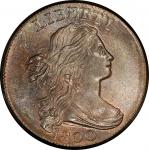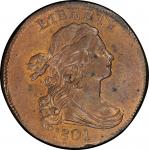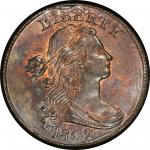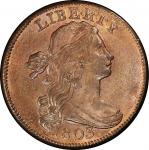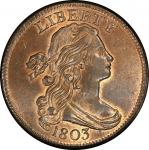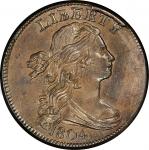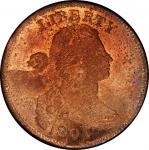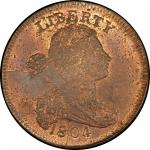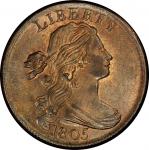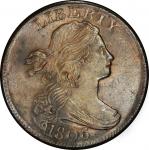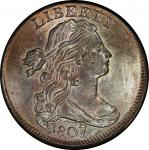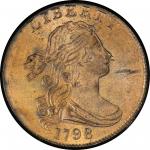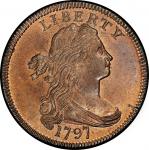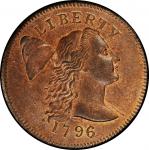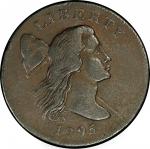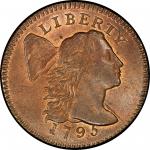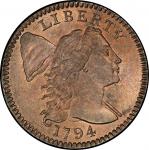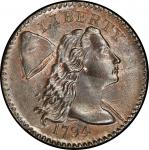If that sale had been handled by Stacks or New Netherlands, that sale would have been a pretty famous little sale. A lot of people all over the country would have participated. - C. Douglas Smith on the Leonard M. Holland sale of 1959, as recounted in Penny-Wise, July 1978Rich and frosty cartwheel luster encircles both sides to splendid effect, emboldening the corona of mint color that surrounds the portrait of Liberty on the obverse. The reverse shows even more mint color, barely mellowed to light brown and steel where it does not remain fully bright. Both sides show highly attractive contrast between the light colored fields and the devices, though softness of strike affects several design elements. Libertys cheek and profile are bluntly rendered, allowing a mark located at Libertys cheek to remain visible after striking. The tip of her bust and leaves located in the lower half of the wreath are likewise a bit flat. The obverse shows some denticles framing the upper left, while the reverse features a nearly full complement, just a bit soft atop that side and somewhat short in length at the bottom. The surface quality is excellent, with the freshness and frostiness of both sides, evident under even casual examination, and becoming more convincing under magnification and light. A short scratch under Libertys neck curl is the only significant post-striking flaw. A natural planchet flaw was not fully struck out at F of OF.This variety, long called the "Q" variety for the shape of the spalling breaks near the date, appears in a collectible array of die states. This piece shows a state equivalent to Breens State III, though what he terms "nearly horizontal cracks" in Libertys hair are actually lapping lines, or more likely lathe marks, as is the line from the lowest curl through 18 of the date. The die clashes the lapping was meant to correct have left an impression of denticles from below the date to 9:00 on the obverse, impressions of the tip of Libertys bust beneath ES OF on the reverse, along with more evidence in the center right and lower right portions of the wreath. The clash marks are far from the worst of the abuse these dies had to endure, however. A substantial chunk has fallen from the top of the obverse, leaving a wedge-shaped break between IB of LIBERTY. Another break is present below BE of that word, and the spalling eruptions that give this variety its moniker are prominent among the 00 digits of the date. Other spalling is seen at the lower left of the hair ribbon, in the distant lower right obverse field, on either side of the fraction bar, and below TE of STATES.This coin does not represent the finest work the coining shop of the First Philadelphia Mint could produce. It does, however, represent the very finest state of preservation known among specimens of this die variety, a consensus title it has worn without challenge for the better part of a century.Leonard Holland got this cent from his friend Thomas Elder, the longtime coin dealer whose affairs he helped organize as Elder lay dying in Greenville, South Carolina in the late 1940s. Perhaps this cent was among the coins Elder had set aside for himself; perhaps Holland had acquired it earlier. It was among those pieces Holland put up for collateral on a bank loan in Pennsylvania in the late 1950s, all coins of uniformly superb quality that ended up unceremoniously sold by a local auctioneer when Hollands non-numismatic investment went sour. The auction became a feeding frenzy of the cognoscenti, many of whom carpooled down from New York and split the coins up in a hotel room auction held after the original auction farce had ended with low prices and curiously little bidding. Many of the best coins were sold to Louis Helfenstein, then a relative novice whose willingness to pay top prices for top quality made him both a target and a punchline for many of his contemporaries. This coin was sold at the 1959 Holland sale for $140, and then resold to Helfenstein for $325 shortly thereafter. It realized $1,800 at the 1964 Lester Merkin sale of Helfensteins collection. By that point, one might presume no one was making fun of him anymore, but that presumption would be wrong.Dorothy Paschals raw emotion about the sale came out in a September 18, 1964 letter to Robert S. Carter, reprinted in Penny-Wise, July 1990:I went to the Helfenstein sale intending to make about two or three expensive bids but as the opening bids were higher than the top-most figure I could or would pay, it was a shut-out. As a spectacle it was quite a circus with people apparently eager to pay four and five times what those coins could possibly be worth. The perpetrators of such a sale (and I dont mean Lester Merkin, the dealer, who knows little about Cents) have really put something over on the public ruthlessly and unscrupulously.The next time this coin sold, it brought $3,300 in a 1973 Merkin sale. While a somewhat secretive clique of enthusiasts was able to control the meager population of top quality early cents for decades, the mid 1960s finally saw the cat out of the bag. The cataloging style that Paschal lampooned as "a mush of superlatives further glorified by color photographs on the front cover - a new process" not only revolutionized the large cent specialty, but became mainstream throughout American numismatics as the hobby evolved into an industry. While Paschal denounced Helfensteins quality-first collecting style, proclaiming, "he has never been interested in varieties - only gems of the common varieties," his methodology has become the primary manner in which great cabinets are assembled today. Paschal complained bitterly "Helfenstein was not a collector in my opinion, he was merely a speculator who started buying gem coins a few years ago," but Helfensteins departure from the large cent field after collecting the series for over a decade was followed by fascinations with half cents, Bust half dollars, and other specialties. C. Douglas Smith recalled in 1978, as recorded in the July 1978 issue of Penny-Wise, "Lou right away got interested in collecting large cents, and he early decided to collect just the top quality large cents. As far as prices went, he just decided to buy any coin he liked and the heck with the price, and he had enough money to do it."Walter Breen, the cataloger of the Helfenstein sale, crowed in 1964 "the importance of this one soars. It must be seen to be believed," precisely the sort of language that upset the woman known as "Dr. Dorothy." While Breens style wasnt to her taste, nor was he wrong. This specimen is the single finest known from these dies and ranks as one of the best 1800 cents of any variety surviving today.

